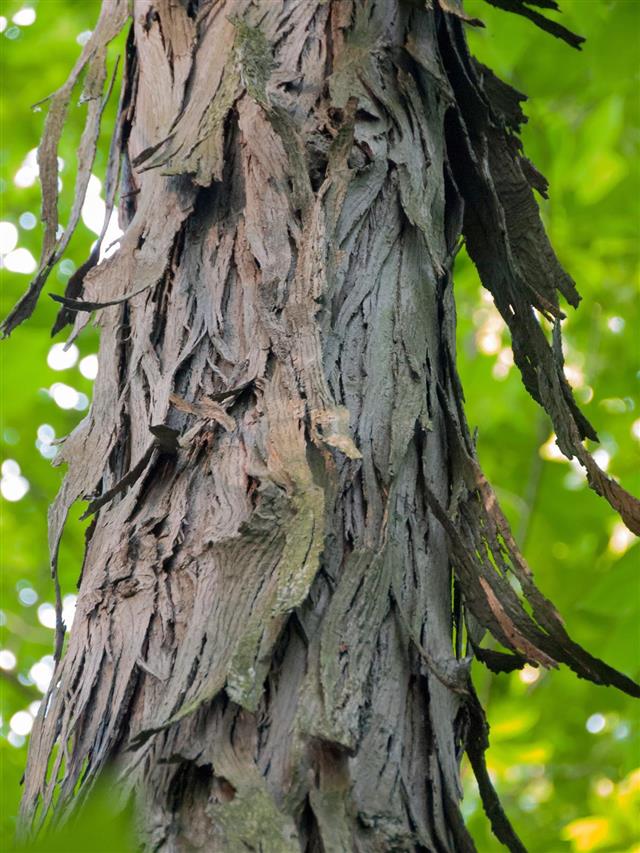
You may find it difficult to identify a hickory tree, as there are different species that vary in appearance. Here are some tips for identifying these trees.
Hickory trees are commonly found in North America and certain parts of Asia. These trees belong to the genus Carya in the family Juglandaceae. There are around 19 species of hickory trees in the genus Carya. Around 11 to 12 species are found in the United States. Some of the commonly found species in North America are pignut hickory (Carya glabra), shagbark hickory (Carya ovata), shellbark hickory (Carya laciniosa), pecans (Carya sect. Apocarya), and bitternut hickory (Carya cordiformis). As most of them look somewhat similar, identification of individual species may become difficult.
How to Identify Hickory Trees
In general, hickories can be described as deciduous trees with pinnately compound leaves. The yellowish-green flowers, develop as drooping catkins of three groups. They produce large nuts, which are edible in some species, like pecans. These nuts are round with four-valved husks. Hickory tree nuts are dusty yellow in color, and have a length of one to two inches. While mockernut has reddish-brown husks, those of pignut hickory have no ribs. Shellbark hickory produces the largest nuts, among the different hickory species; and they are also sweet and edible. The following are some of the general observations that may help you in identifying hickory trees.
Height of the Tree
Even though, it is difficult to identify different hickory species on the basis of tree height, there are certain factors that may help you in this task. The shortest among the hickory species is shellbark, with a height of around 30 to 60 feet, and a trunk diameter of one to three feet. You may find bitternut, mockernut, and pignut hickory trees with a similar trunk diameter, but a height of around 50 to 70 feet. Shagbark hickory may grow to a height of 60 to 80 feet, but some of them may attain a height of more than 100 feet.
Shape of Leaves
Another common feature that will help you in hickory tree identification is the pinnately compound leaves with several leaflets. Almost all species, except pignut and shagbark hickories have seven to 11 leaflets. Pignut and shagbark hickories have five to seven leaflets. In case of pecans, the number of leaflets can be around 17. So, hickory leaves always have an odd number of leaflets.
Finely-toothed leaflets are found in bitternut, mockernut, pignut, and shagbark hickories. Mockernut hickory leaves have a dense hairy underside and an orangish-brown color. These leaves are also aromatic. Even bitternut hickory leaves have a slightly downy underside.
Even though, the leaf color is green in different hickory species, you may find them in different shades. Shagbark hickory tree has yellowish-green leaves, whereas, nutmeg hickory leaves have a whitish underside with dark green upper surface. Most of the hickory trees change foliage color to yellow, during fall. Another point of distinction between the different species is the shape of the crown, which is rounded in mockernut, and cone-shaped in bitternut. Pignut hickory has droopy or spreading branches.
Color and Texture of Bark
Bitternut hickory bark is thin, tight, and hard with a gray color; that changes to silvery shades, as the tree ages. Even the bark of this tree develops shallow furrows and ridges with age. In young pignut hickory trees, the bark is found to be smooth with a light gray color. As they age, the color changes to dark gray, and the tree develops scaly ridges. Shagbark hickory tree has a light gray bark that peels as thick vertical plates; with a length of more than a foot, and both ends curling outwards. Similarly, shellbark hickory tree can be identified with its peeling bark that comes out in small strips.
In short, hickory tree identification can be a little tricky, as you may come across different species. The above said is only a brief overview about their features, that may help you in identifying these trees. However, a detailed study about individual species will be always beneficial in distinguishing them.







